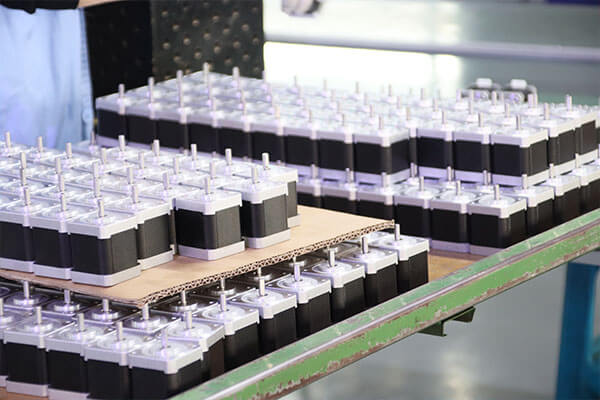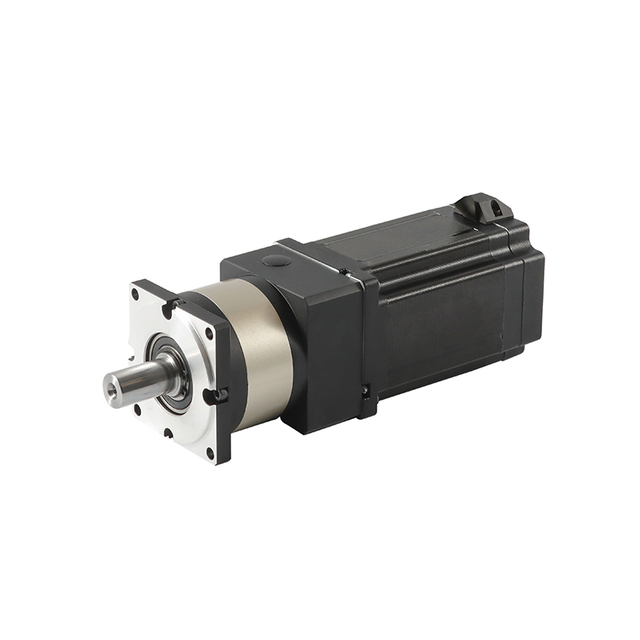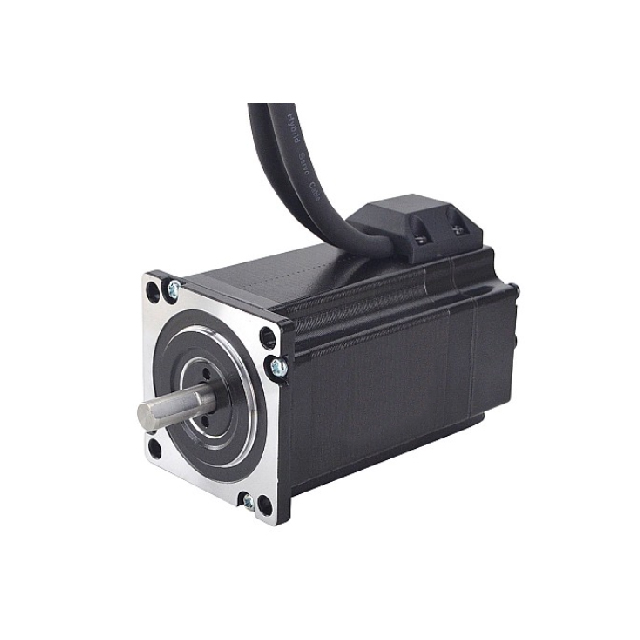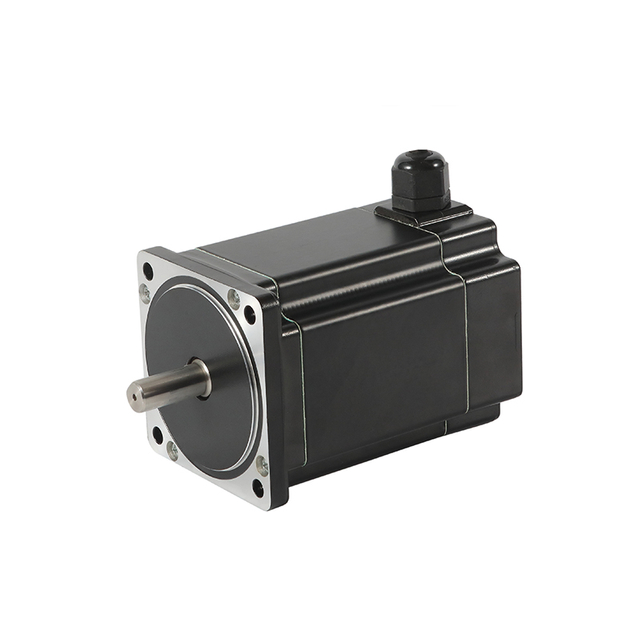
In modern smart factories and logistics networks, Automated Guided Vehicles (AGV) and Autonomous Mobile Robots (AMR) have become essential tools for improving throughput, reducing labor costs, and guaranteeing material transport accuracy. At the core of these robotic platforms is the motion control architecture, where stepper motors deliver reliable, high-precision positioning, smooth operation, and cost-efficient performance.
This comprehensive guide explores why stepper motors are ideal for AGV and AMR applications, their key advantages, selection criteria, integration essentials, and the future potential for intelligent motion systems in industrial automation.
Why Stepper Motors Are Used in AGV / AMR Applications
Stepper motors play a crucial role in Automated Guided Vehicles (AGVs) and Autonomous Mobile Robots (AMRs) thanks to their exceptional positioning accuracy, reliability, and cost-efficient motion control. These robots rely on consistent, precise movement for navigation, load handling, and docking, and stepper motors deliver the exact performance profile needed for these missions.
1. Precision Positioning Without Complexity
AGV and AMR platforms require accurate positioning at low speeds, especially during tasks like docking, pallet pickup, and shelf alignment. Stepper motors operate using discrete stepping increments, allowing them to provide precise, repeatable motion without requiring complex encoders or feedback systems.
Even in open-loop systems, they can maintain excellent positional accuracy for typical warehouse and factory tasks.
2. Strong Low-Speed Torque
Unlike other motor types that need gearing or feedback control to maintain torque at low speed, stepper motors naturally deliver high torque at low RPMs, making them ideal for:
Smooth, controlled acceleration
Precise maneuvering in tight lanes
Heavy payload movement on flat floors
This ensures stable traction and consistent motion performance, which are mission-critical in logistics applications.
3. Energy-Efficient Operation for Battery-Powered Robots
AGV and AMR systems depend on efficient power usage to maximize operational hours. Modern stepper drivers feature:
This combination helps extend battery life, ensuring longer duty cycles between charging.
4. Simplified Control and Integration
Stepper motors are straightforward to integrate with industrial controllers, ROS systems, and onboard robot motion processors. Their drive architecture offers:
Easy position command execution
Minimal tuning requirements
Compatibility with common motion protocols
This reduces engineering time, wiring complexity, and overall system cost.
5. Reliability and Low Maintenance
Mobile robots operate constantly in industrial environments where durability is essential. Stepper motors are:
This translates to higher robot uptime and reduced maintenance costs, key benefits for 24/7 material-handling fleets.
6. Ideal for Multi-Axis Auxiliary Motion
Beyond propulsion, AGVs and AMRs often include mechanisms like:
Lifts and elevating forks
Conveyor modules
Grippers or alignment actuators
Scanning and sensing actuated mounts
Stepper motors excel in these secondary motion systems, delivering high control resolution in compact form factors.
Bottom Line
Stepper motors are widely used in AGV and AMR platforms because they deliver the perfect mix of precision, torque, reliability, cost-efficiency, and energy performance. As robotics continues evolving, stepper technology — especially with closed-loop feedback and integrated control — remains a core motion solution for mobile automation.
Advantages of Stepper Motors for AGV and AMR Robotics
1. Exceptional Motion Precision
Stepper motors move in discrete steps, offering precise incremental motion ideal for:
Navigation and path following
Precise docking at charging and loading stations
Lift and conveyor positioning
When paired with closed-loop feedback, they achieve servo-like accuracy while maintaining smooth operation.
2. High Torque at Low Speeds
AGVs and AMRs often operate in low-speed environments where torque is essential for traction and payload movement. Stepper motors inherently provide strong low-speed torque, supporting:
High-weight transport capability
Precise movement even in congested factory layouts
Controlled acceleration to ensure payload stability
3. Energy Efficiency and Battery Compatibility
Battery life is key for mobile robotics. Stepper motors, particularly hybrid stepper designs, offer strong efficiency characteristics, including:
Optimized power consumption profiles
Advanced drivers with current control and auto-sleep features
Reduced heat generation for energy conservation
4. Robustness and Reliability
Industrial automation systems must operate continuously. Stepper motors offer:
Minimal maintenance requirements
Long operational life under heavy use
Resistance to industrial vibration and shock
5. Simplified System Integration
Stepper motors support simple control logic, reducing system architecture complexity:
Types of Stepper Motors Used in AGV / AMR Platforms
Most common in mobile robotics due to:
High torque density
Smooth movement
Superior step accuracy
Modern compact solutions featuring:
Built-in driver and encoder
Reduced wiring complexity
Lower electromagnetic interference
Faster implementation and smaller footprint
Ideal for AGV/AMR steering, conveyor lift, and auxiliary systems.
For applications requiring servo-like feedback precision:
Encoder-supported position correction
Automatic stall prevention
Higher efficiency under varying loads
These systems combine stepper simplicity with servo intelligence.
Choosing the Right Stepper Motor for AGV / AMR Applications
When selecting stepper motors, consider these engineering criteria:
Selecting the proper stepper motor is essential to ensure a reliable, efficient, and long-lasting AGV or AMR system. The right motor must provide stable movement, sufficient torque for payload handling, and smooth positioning for accurate navigation and docking tasks. When engineered correctly, the system delivers quiet operation, extended battery life, and long-term service durability.
Below are the key factors and engineering considerations for choosing the optimal stepper motor for mobile robotic platforms.
1. Torque and Load Requirements
AGVs and AMRs must move smoothly and safely while carrying diverse payloads. Motor torque selection should consider:
Vehicle base weight plus maximum payload
Floor friction and wheel rolling resistance
Incline requirements, if applicable
Start-stop load surges and acceleration forces
Undersizing torque results in motor overheating, step loss, or vibration during acceleration. Many systems benefit from hybrid stepper motors, which deliver high holding torque and controlled movement at low speeds.
2. Voltage and Power Efficiency
Battery-driven robots demand motors optimized for power consumption to maximize runtime. Typical AGV/AMR voltage platforms are 12V, 24V, or 48V. Key power criteria include:
Current requirements at peak torque
Holding torque vs. idle power draw
Efficiency of microstepping control
Standby and sleep functionality in drivers
A properly matched stepper motor and intelligent driver help reduce heat waste and improve energy efficiency across the fleet.
3. Closed-Loop vs Open-Loop Control
While traditional stepper motors operate open-loop, many AGV/AMR manufacturers prefer closed-loop stepper motors for enhanced reliability and servo-like performance.
| Feature | Open-Loop Stepper | Closed-Loop Stepper |
| Accuracy | High | Higher with feedback |
| Efficiency | Standard | Improved, adjusts current |
| Stall Detection | No | Yes, prevents lost steps |
| Heat Management | Constant current | Dynamic current adjustment |
| Best Use | Light to moderate loads | Variable loads, safety-critical motion |
Closed-loop systems provide real-time correction, enabling precise navigation, safer operation, and battery savings.
4. Motor Size and Frame Type
Common NEMA frame sizes for AGV/AMR platforms include:
NEMA 17: Small conveyors, sensor actuators, lightweight robots
NEMA 23: Most mid-range AGVs and AMRs for traction and lifting
NEMA 34: Heavy-duty robots and high-payload transporters
Size selection should balance torque, footprint, and thermal management. Larger frames increase power but also add weight, affecting battery efficiency.
5. Environmental and Durability Requirements
Mobile robots encounter continuous motion, vibration, and industrial environments. Ideal stepper motor characteristics include:
High vibration and impact tolerance
Durable bearings and shaft design
Optional IP-rated sealing for dusty or humid locations
Low-noise performance via quality drivers and microstepping
For harsh manufacturing or warehouse environments, motors with reinforced housings and sealed connectors increase longevity.
6. Driver and Control System Compatibility
Motor performance is only as strong as its control electronics. Look for features such as:
Advanced microstepping resolution for smooth motion
Dynamic current adjustment
CANopen, EtherCAT, or industrial Ethernet support
ROS compatibility for autonomous navigation frameworks
Stepper drivers with auto-tuning, stall prevention, and real-time torque control elevate system stability.
7. Integrated Motor Solutions
Integrated stepper motors combine motor, encoder, and driver in a compact assembly, simplifying wiring and reducing EMI noise. Benefits include:
Space-saving design
Faster assembly and maintenance
Built-in diagnostics and health monitoring
Stable and quiet performance
These units are increasingly preferred in next-generation AMR systems focused on modular design and serviceability.
Conclusion
Choosing the right stepper motor for AGV and AMR applications requires balancing torque, efficiency, control method, and durability with the operational demands of mobile platforms. Hybrid and closed-loop stepper solutions, paired with intelligent drives and integrated control technology, provide the reliability, precision, and battery performance needed for continuous industrial operation.
A thoughtful motor selection strategy results in robots that move smoothly, operate longer per charge, and remain reliable across diverse environments and loads.
Applications of Stepper Motors in AGV / AMR Systems
Drive Wheels and Navigation Modules
Precision movement for:
Lifting and Material Handling
Stepper motors power:
Docking and Charging
Essential for controlled alignment during:
Auxiliary Systems
Including:
Stepper vs Servo Motors in AGV / AMR Design
| Feature | Stepper Motor | Servo Motor |
| Cost | Lower | Higher |
| Precision | High | Very High |
| Low Speed Torque | Excellent | Good |
| Maintenance | Minimal | Moderate |
| Control Complexity | Simple | More complex |
| Best Use Case | Stable load and precise low-speed control | High-speed dynamic load changes |
For many AGV/AMR use cases, stepper motors provide optimal performance at lower cost, especially with modern closed-loop systems.
Future Trends in Stepper-Driven AGV / AMR Systems
Automation is accelerating quickly, and AGV/AMR motion technology is evolving with it. Stepper motors, once seen as simple open-loop devices, are now stepping into the era of intelligent, connected, and highly optimized robotics systems. The next generation of AGV and AMR platforms demands efficiency, precision, diagnostic capability, and long-term reliability, and stepper technology is advancing to meet those expectations.
1. Integrated Intelligent Stepper Motors
The shift toward all-in-one motion modules is reshaping robot design. Instead of separate controllers, drivers, and encoders, modern integrated steppers offer:
In-motor microcontrollers and DSPs
Built-in motion algorithms and safety logic
Fieldbus communication interfaces
Self-tuning and auto-configuration
This architecture delivers simpler wiring, reduced EMI noise, and faster assembly, all crucial for modular robot systems and scalable fleet deployment.
2. Advanced Closed-Loop Feedback and Predictive Control
The industry is quickly moving beyond traditional stepper control. New closed-loop platforms provide:
High-accuracy encoder feedback
Adaptive torque management
Real-time stall detection and correction
Vibration and resonance damping algorithms
More importantly, emerging designs integrate predictive motion intelligence, allowing systems to anticipate load changes and optimize power draw on the fly. The result is servo-class performance with the cost stability and low-speed torque benefits of stepper motors.
3. High-Efficiency Power and Thermal Management
Battery life and continuous operation are central to mobile robot performance. Future stepper solutions focus on:
Ultra-low idle current modes
Dynamic current scaling based on load
High-efficiency MOSFET driver technology
Improved winding and magnetic materials for lower heat
These developments extend operating time, shrink cooling requirements, and reduce overall energy cost per robot.
4. Modular Mechatronic Platforms
Robotic OEMs are adopting modular structures to simplify production and maintenance. Stepper systems are evolving into plug-and-play motion modules that incorporate:
This approach enables rapid field replacement, fast scaling, and streamlined upgrades, ideal for high-volume robotic fleets.
5. On-Motor Diagnostics and Data Connectivity
Industrial automation is becoming data-driven. Enhanced stepper platforms now support:
On-motor current and temperature sensing
Motor health and load monitoring
Predictive failure analytics
CAN, EtherCAT, Profinet, and Ethernet-based diagnostics
These smart motors feed continuous operational data into fleet-management software, enabling remote health monitoring, predictive maintenance, and reduced downtime.
6. Noise and Vibration Reduction Technologies
As AMRs move increasingly into human-working spaces, motion smoothness matters. Expect innovations in:
Microstepping algorithms with higher interpolation resolution
Magnetic design improvements to minimize cogging
Integrated damping and anti-resonance control
These upgrades mean quieter, smoother, and more stable motion, even during slow or precision movement tasks.
7. Eco-Optimized Robotics Technology
Sustainability trends are pushing component manufacturers to rethink efficiency and materials. Stepper motor developments include:
Recyclable motor components
Reduced metal content through design optimization
Higher copper-efficiency coils
Low-loss power electronics
These eco-conscious improvements help AGV and AMR manufacturers build greener logistics ecosystems.
8. Hybrid Stepper-Servo Fusion Drives
A growing segment of the robotics market is adopting hybrid stepper-servo solutions. These combine:
Stepper low-speed torque advantage
Servo smoothness and dynamic control
Closed-loop feedback
Minimal tuning and simpler commissioning
This fusion yields precise, responsive, and efficient motion, especially for robots operating under varied payload conditions.
Stepper technology is rapidly evolving to support the growth of mobile robotics. As AGVs and AMRs become smarter, more connected, and more energy-efficient, stepper motors will continue playing a central role in motion control thanks to their balance of precision, cost-efficiency, torque performance, and reliability. With integrated intelligence, predictive control, enhanced energy performance, and diagnostic capability, tomorrow's stepper-powered robots will be faster to deploy, easier to maintain, and more efficient to operate.
Conclusion
Stepper motors are a critical enabling technology for modern AGV and AMR systems, offering unmatched balance between precision, cost-efficiency, and reliability. With strong torque performance, simplified integration, low maintenance, and smart control options, they empower industrial robots to operate efficiently in high-demand logistics and manufacturing environments.
Organizations that adopt advanced stepper motor technology, particularly integrated and closed-loop solutions, achieve superior fleet performance, reduced downtime, and scalable automation success.
English
العربية
Français
Русский
Español
Português
Deutsch
italiano
日本語
한국어
Nederlands
Tiếng Việt
ไทย
Polski
Türkçe
ພາສາລາວ
ភាសាខ្មែរ
Bahasa Melayu
ဗမာစာ
Filipino
Bahasa Indonesia
magyar
Română
Čeština
Монгол
қазақ
Српски
हिन्दी
فارسی
Slovenčina
Slovenščina
Norsk
Svenska
українська
Ελληνικά
Suomi
Հայերեն
עברית
Latine
Dansk
Shqip
বাংলা
Hrvatski
Afrikaans
Gaeilge
Eesti keel
Oʻzbekcha
latviešu
Azərbaycan dili
Български
Català








